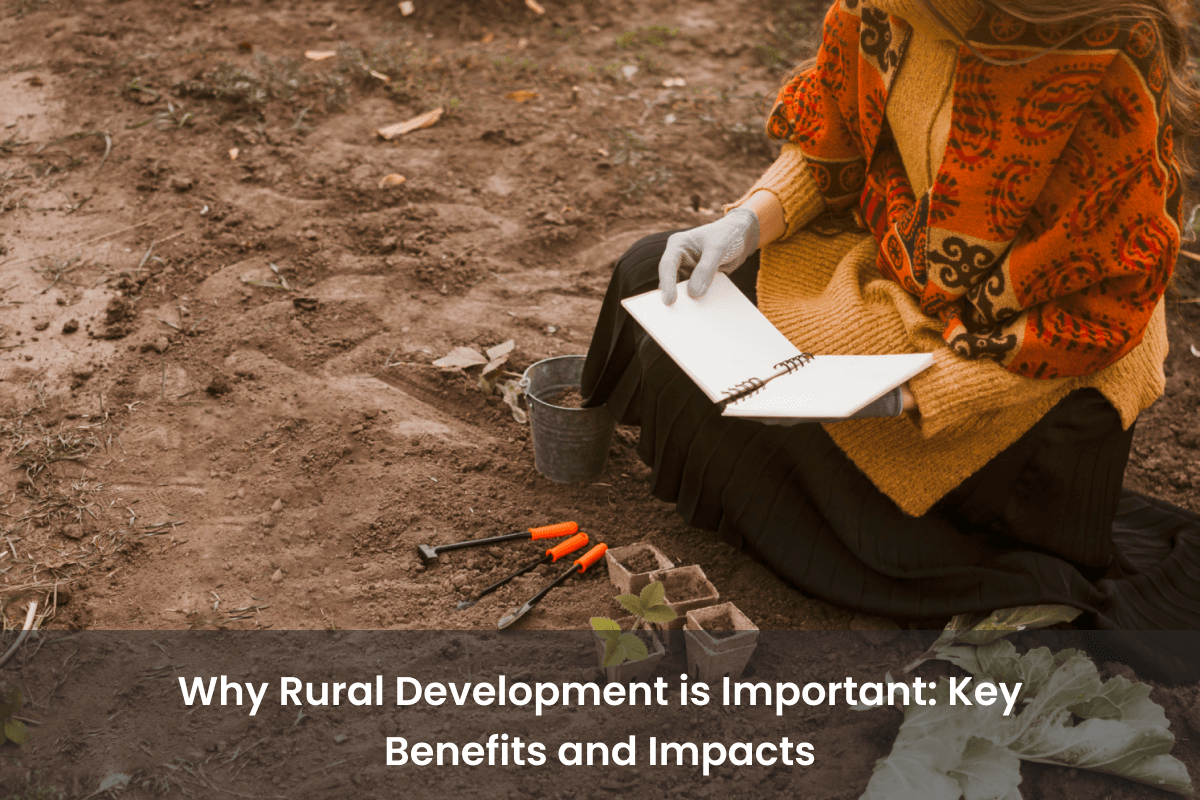Rural development ensures poised and balanced growth of the nation. It is based on dealing with some of the most pressing issues in rural communities—infrastructure, economy, and improved living conditions. Lately, some of the current basic issues are at the borderline of poverty, unemployment, and limited access to health care and education. Investing in rural development enhances the productivity of such crucial industries as agriculture, hence fastening the growth of the national economy. Less rural-urban migration due to developing rural economies reduces urban congestion and spreads the fruits of economic growth between regions more equitably. Rural development encourages entrepreneurship, regional enterprises, and sustainable farming methods hence diversifying the economy.
Social and environmental impacts are considerable in addition to the economic benefits of rural development. It improves the livelihood through enhanced access to essential services and further empowers rural community development, enhancing social equity. A well-linked region with good roads, schools, and medical facilities brings about equality in education, employment, and health for rural populations and reduces isolation. In addition, sustainable practices in rural development aim at conserving natural resources and ensuring environmental protection. Ecosystem conservation and environmental management are promoted in rural development through the utilization of sustainable agriculture, alternative energy programs, and land-use legislation that is being considerate of these principles. At the end of the day, for the social, economic, and environmental development of a country, nurturing a self-sufficient, dynamic, and sustainable rural community is very important.
What is Rural Development?
The process of enhancing the standard of living and financial security of residents in rural areas—which are frequently distinguished from metropolitan areas by having lower levels of infrastructure, services, and economic opportunities—is known as rural development. It includes a broad range of initiatives meant to promote social services, ensure sustainable environmental practices, and boost economic growth in rural areas. The goal of this development strategy is to create equitable economic possibilities for rural communities while enhancing important industries like infrastructure, healthcare, education, and agriculture. In addition, rural development aims to give communities the means to escape the cycle of poverty and make a significant contribution to the development of the country by giving them access to opportunities, resources, and decision-making authority.
Progress in the social, environmental, and cultural domains is included in rural development, in addition to economic growth. Initiatives for sustainable rural development prioritize modernization and innovation in farming methods, renewable energy sources, and small-scale industries while highlighting the value of maintaining regional customs and ecosystems. Rural development’s fundamental goal is to provide local communities the tools they need to take control of their own development and solve their own special problems by working together to plan and make decisions. Rural communities can become more resilient, self-sufficient, and able to support larger national growth by emphasizing holistic and sustainable development.
Related Blog: What is Rural Development? An In-depth Overview
Why is Rural Development Important?
Because rural populations frequently experience poverty, restricted access to basic services, and unstable economies, rural development plays a critical role in promoting a fair and inclusive society. The majority of people on the planet still reside in rural areas, particularly in developing nations, hence funding rural development is essential to preventing these communities from falling behind their metropolitan counterparts. Enhancing roads, schools, and healthcare facilities is only one way that rural development contributes to lowering isolation, expanding access to essential services, and creating more job and educational opportunities. This in turn contributes to the reduction of poverty, raising living standards, and achieving a more equitable distribution of resources and wealth throughout a country.
Furthermore, agricultural productivity and food security—which are essential for local economies as well as the expansion of the country—are made possible through rural development. By decreasing reliance on urban areas and widening the gap between rural and urban areas, stronger rural economies can promote resilience and diversification. In addition, environmental preservation, wise resource management, and maintaining long-term ecological balance are key components of sustainable rural development. Through rural development, a nation’s whole social fabric is reinforced, resulting in a more inclusive and stable society where all regions contribute to the advancement of the nation. Rural areas also become more prosperous and sustainable.
Key Benefits and Impacts of Rural Development
1. Economic Growth and Poverty Reduction:
In areas of the economy where small-scale industry and agriculture are important, rural development is crucial to promoting economic growth. Initiatives for rural development stimulate local economies and enhance income levels for rural residents by boosting agricultural productivity, expanding market access, and upgrading infrastructure. Modern agricultural methods, improved irrigation systems, and financial availability enable farmers to raise yields, diversify their crop portfolios, and pursue new markets. This promotes job development and entrepreneurial growth outside of agriculture while simultaneously bolstering the agricultural industry and other local sectors. As rural economies expand, poverty decreases visibly as household’s experience higher earnings and better living conditions.
2. Enhanced Quality of Life:
Rural development fills in long-standing gaps in access to basic amenities like clean water, healthcare, and education, thereby greatly enhancing the quality of life for residents of rural areas. The lack of access to healthcare institutions and their limited resources in many rural regions result in greater rates of disease, shorter life expectancies, and subpar maternity and child health services. Programs for rural development that place a high priority on constructing medical facilities, hiring qualified medical staff, and guaranteeing drug availability can significantly enhance health results. Increased life expectancy, a decrease in preventable diseases, and an improvement in population health all result from improved access to healthcare, enabling people to live longer, healthier lives.
3. Social Equity and Inclusion:
Ensuring that all residents of rural communities have equitable access to resources, opportunities, and services is made possible through rural development, which plays a crucial role in advancing social justice and inclusion. Education, healthcare, and job restrictions are common for marginalized groups in rural locations, including women, indigenous communities, and lower socioeconomic strata. Initiatives for rural development are concentrated on removing these obstacles by putting in place laws and plans that provide everyone’s access to resources first priority. This can entail giving women access to vocational training and education, providing underserved communities with focused healthcare services, and making sure that marginalized groups are heard in community planning and decision-making processes. Rural development encourages inclusivity in order to create a more unified and just society where everyone has the chance to prosper.
4. Sustainable Environmental Practices:
Ensuring that social advancement and economic expansion do not come at the expense of the environment is why sustainable environmental practices are so important to rural development. The land, rivers, and forests that surround them provide a major source of income for many rural populations. These resources could run out or deteriorate without sustainable methods, which would present long-term problems for the environment and the economy. Sustainable practices are a key component of rural development projects that support the livelihoods of rural inhabitants while promoting responsible resource management and ecosystem preservation. To improve productivity while preserving the environment, this involves promoting the use of agroforestry, conservation agriculture, and sustainable water management practices.
5. Rural-Urban Balance and Stability:
By resolving the differences between rural and urban areas, rural development is essential to establishing a stable and balanced socioeconomic structure. Rural areas frequently experience serious problems like poor infrastructure, few economic prospects, and insufficient services, all of which lead to high rates of migration to urban areas. Increased urban-rural disparity, congested cities, and stressed urban infrastructure can result from this migration. Investments in infrastructure, services, and economic opportunities that prioritize rural development contribute to the creation of desirable and sustainable living environments in rural areas, which can lessen the strain on urban centers and entice people to stay in or move back to their rural communities.
Role of NGOs in Rural Development
Non-Governmental Organizations (NGOs) are essential to rural development because they fill program gaps in the government and provide underprivileged areas with specialized knowledge and resources. NGOs frequently work in places where the government has limited influence or where certain local needs are not sufficiently met. They concentrate on a variety of topics, such as environmental sustainability, agriculture, healthcare, and education. NGOs make guarantee that development initiatives are suited to the unique needs and circumstances of rural communities by putting community-driven programs into action and encouraging local engagement. Because of their presence on the ground, they are able to collaborate directly with communities, foster trust, and develop solutions that are both workable and sensitive to cultural differences.
Non-governmental organizations (NGOs) frequently act as representatives for underrepresented communities, bringing attention to matters including gender disparity, social isolation, and environmental deterioration. In order to increase their influence, they are essential in raising money, assembling resources, and forming alliances with other groups and interested parties. NGOs enable local communities to actively participate in their own development by means of capacity-building projects and training programs, so promoting self-sufficiency and enduring sustainability. NGOs contribute to the creation of more fair, inclusive, and sustainable outcomes for rural communities by offering fresh perspectives to rural development and bolstering government initiatives.
FAQs About Importance of Rural Development
Q1. Why is Rural Development important to a Country’s Economy?
A nation’s economy depends heavily on rural development since it has a direct impact on regional stability, poverty alleviation, and economic progress. A nation’s agricultural sector, which is essential for both food security and rural employment, is frequently centered in rural areas. Enhancing production and efficiency in these vital sectors, rural development invests in new farming practices, builds local economic possibilities, and improves infrastructure. This in turn increases stability and total economic production. Furthermore, as rural areas grow, they can support small companies, diversify local economies beyond agriculture, and create new industries that will help balance the economy between rural and urban areas. All of these factors will contribute to the expansion of the national economy.
Q2. What are the Major Benefits of Infrastructure Improvement in Rural Areas?
Improving rural areas’ infrastructure has significant positive effects and is essential to raising the standard of living and economic sustainability of these communities. Above all, easier and more effective access to marketplaces, medical facilities, and educational facilities is made possible by improved infrastructure, which includes roads, bridges, and transit networks. This connectivity lessens isolation, facilitates better access to basic services, and lets rural communities interact more successfully with the larger economy. Improved transportation infrastructure also makes it possible for small companies and farmers to move commodities more effectively, which can open up new markets and raise income levels.
Q3. What contribution does agriculture make towards the development of rural settings?
As the main source of income for many rural communities and the engine of social and economic advancement, agriculture is fundamental to the development of rural areas. Agriculture makes a variety of contributions to rural development. First of all, it gives a sizable section of the rural population income and work prospects. Initiatives for rural development can raise crop yields, diversify sources of income, and strengthen the financial stability of farming households through bettering agricultural methods, granting access to technology, and establishing market connections. This economic stimulus promotes wider economic activity in rural areas and helps local companies.
Q4. How does rural development help in the reduction of poverty?
Addressing the underlying causes of economic inequality and enhancing living circumstances in marginalized areas are two ways that rural development helps to reduce poverty. Empowerment on the economic front is one of the main ways rural development lowers poverty. Initiatives for rural development improve the quality of life and foster a more favorable environment for economic activity by funding infrastructure, healthcare, and education. A better income level can be achieved by rural inhabitants by selling their products more successfully and thanks to improved infrastructure, such as roads and transportation networks, which make marketplaces easier to access. A person’s ability to engage in entrepreneurship and obtain better employment prospects is facilitated by investments in education and vocational training, which also help to reduce poverty and accelerate economic growth.
Q5. What is the role of technology in rural development?
By increasing production, expanding service accessibility, and stimulating innovation across multiple industries, technology has a revolutionary impact on rural development. Precision agriculture is one of the cutting-edge farming techniques brought about by technology. It maximizes crop yields and minimizes resource waste through the use of data and equipment. Drastic irrigation, soil sensors, and weather forecasting apps for smartphones are examples of innovations that assist farmers in making well-informed decisions and boost agricultural output and revenue. These technology developments support long-term agricultural growth and food security by increasing farming productivity and aiding in more sustainable resource management.
Conclusion
Finally, rural development plays a critical role in bridging the gap between rural and urban areas as a cornerstone of equitable progress and sustainable growth. Initiatives for rural development are particularly important because they improve the quality of life and promote economic stability by tackling the particular problems that rural communities experience, such as poverty, poor infrastructure, and restricted access to basic services. Enhancing living circumstances, local economies are stimulated, job opportunities are created, and poverty is decreased through investments in infrastructure, healthcare, education, and agricultural productivity. Aside from short-term gains, rural development also ensures that rural communities may participate in and gain from national growth, fostering long-term social and economic resilience.
Support the Cause: Join Us in Enhancing Rural Lives
Rural development has the capacity to change lives, but it will only be effective if people, groups, and communities work together to achieve significant results. You can help build a more just and successful society by endorsing programs that enhance rural communities’ infrastructure, healthcare, education, and economic prospects. Every effort matters, whether it is made in the form of charitable contributions, volunteer work, or support of legislation for rural development. By bridging the gap between rural and urban communities, your involvement promotes more sustainable and balanced growth.As we work to improve rural lives and create stronger, more resilient communities, please join Social For Action. By working together, we can make a positive difference, give local residents more influence, and make sure that growth benefits all aspects of our society. In order to make long-lasting changes and realize a future in which everyone has the chance to prosper, your support is essential. Participate in our campaigns, help us spread the word, and help us solve the problem; after all, every step toward rural development is a step toward a better world for everybody.







Post a Comment